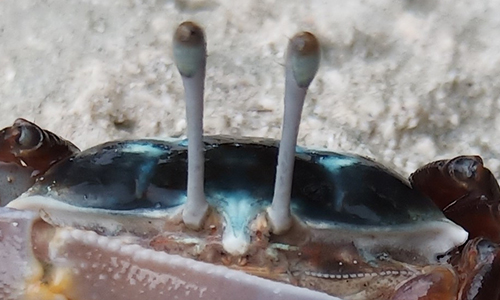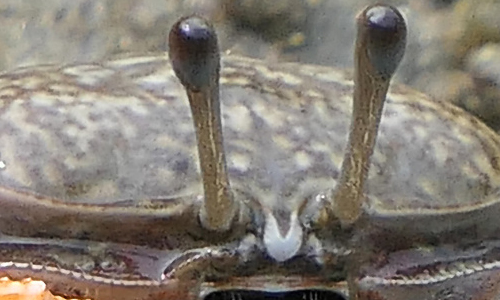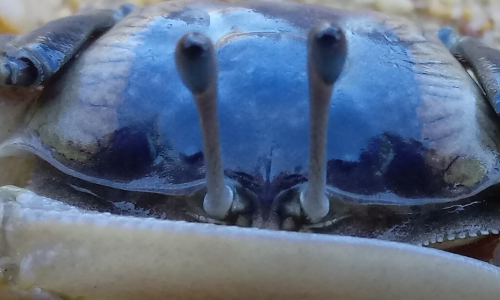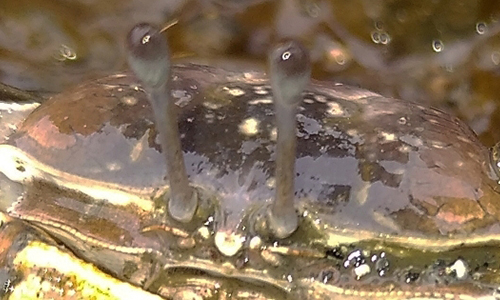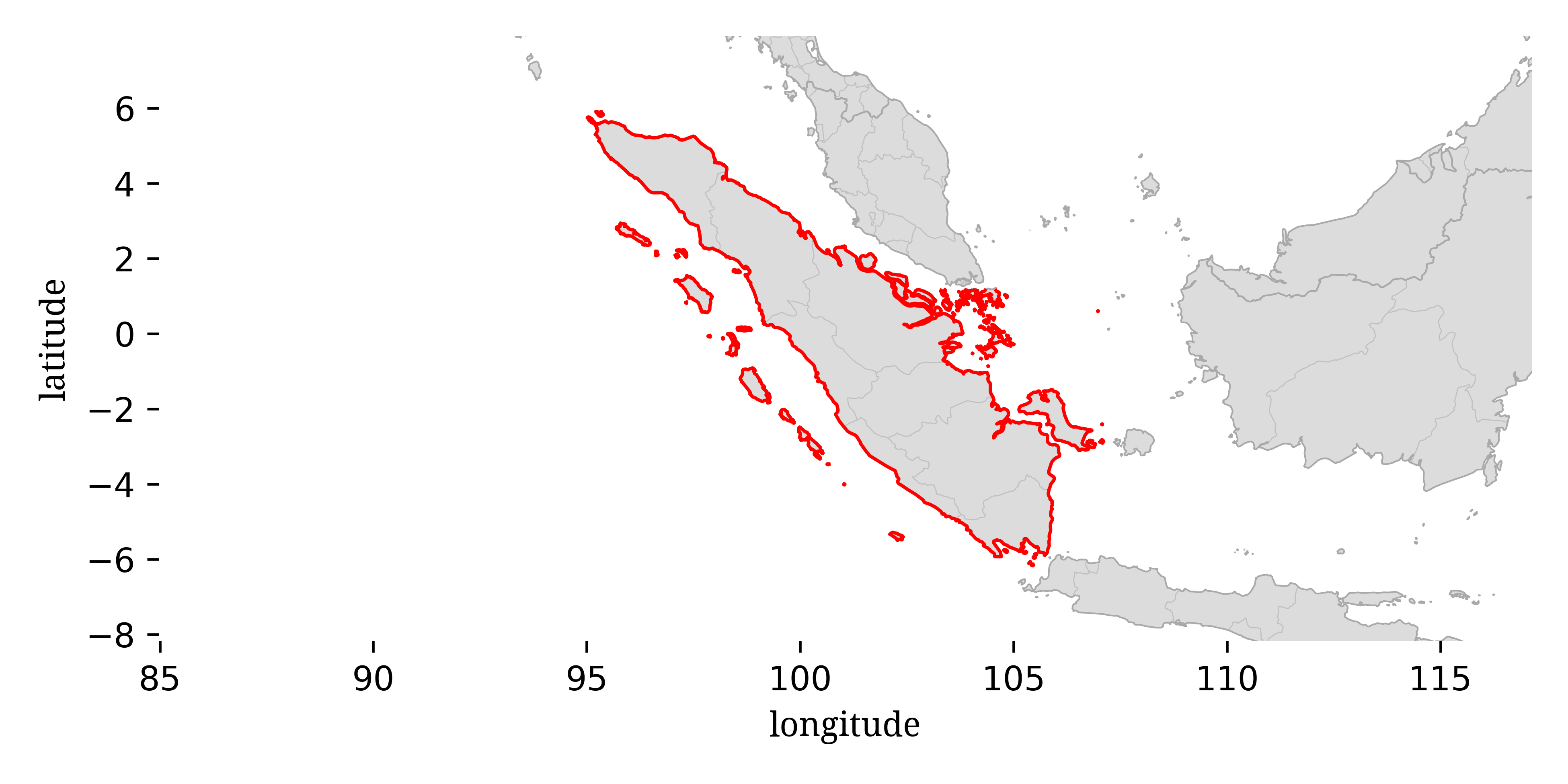
This guide is designed for identification “in the field” where you might be looking at live crabs by eye or through binoculars or from photographs. I will generally try to avoid characters that will require you to physically catch the crab, although I may mention a few for secondary verification. It does not include the more strict taxonomist-style characters that may only be visible under a microscope or via dissection. It is also assumed that the individuals are living, as death (and even capture) can cause dramatic color change.

This is a guide to the fiddler crabs of Sumatra, along with surrounding smaller islands. This is an area with a complex faunal assemblage as it sits at the boundary between the Indian Ocean fauna to the west and the Pacific Ocean fauna to the east. There may be as many as 11 species present:
A number of features can be used to distinguish among these species, but a good place to start is to look at the distance between the base of the eyestalks. Fiddler crabs tend to split into two groups, those with the eyestalks very close together (“narrow front”) and those with the eyestalks separated a bit more (“broad front”). Four of these species (Austruca annulipes, Austruca perplexa, Austruca triangularis, and Paraleptuca crassipes) are broad front species, while the other seven (Gelasimus hesperiae, Gelasimus tetragonon, Gelasimus vocans, Tubuca coarctata, Tubuca dussumieri, Tubuca forcipata, and Tubuca rosea) are narrow front species. Note that the carapace between the eyestalks appears pinched together in the narrow front species, but more trapezoidal in the broad front species.
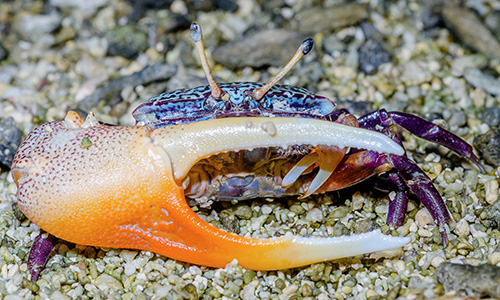
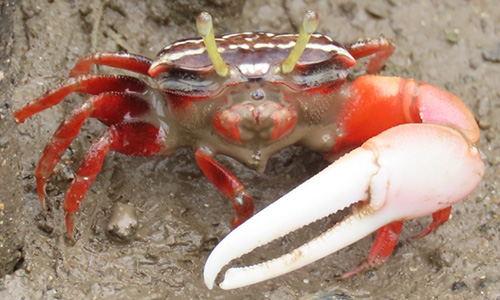
Austruca annulipes is a common, wide-spread species, and probably the most common species in this area. Generally, the carapace of Austruca annulipes tends to be a mix of black and white. The large arm of Austruca annulipes is generally orange or red, with some of the color frequently found on the hand of the claw as well.
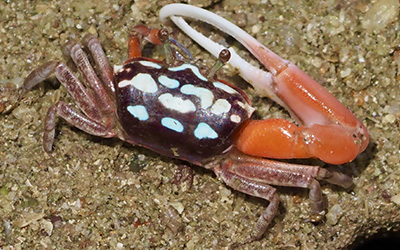
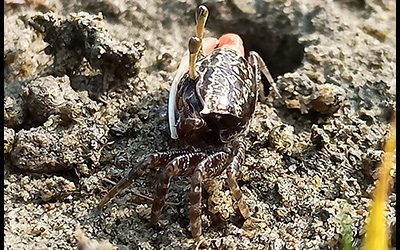
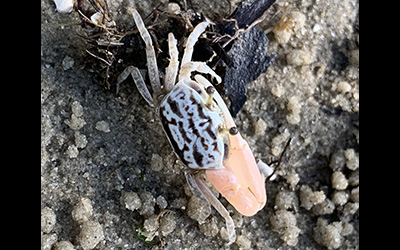
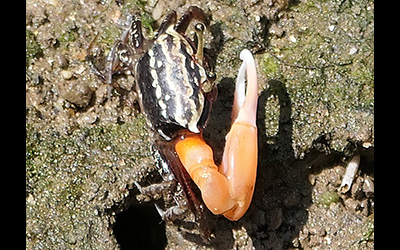
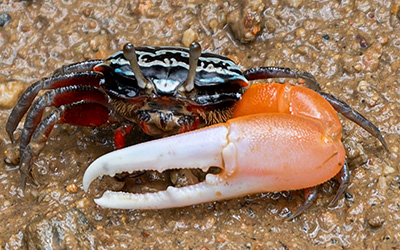
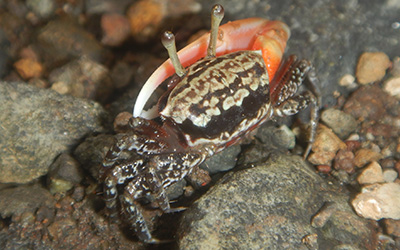
Austruca perplexa is very similar in appearance to Austruca annulipes. Like Austruca annulipes, Austruca perplexa has a carapace that is generally black and white. Austruca perplexa frequently has a claw that is mostly yellow, with occasional solid white claws.
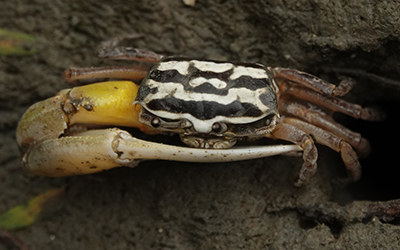

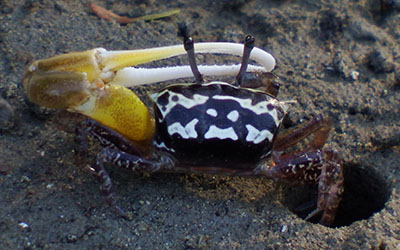
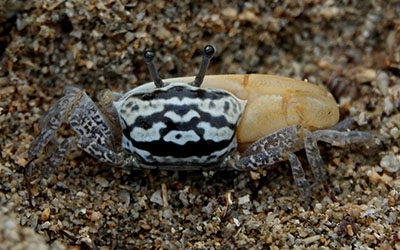
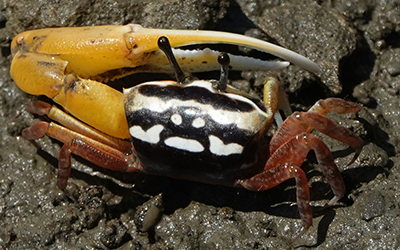
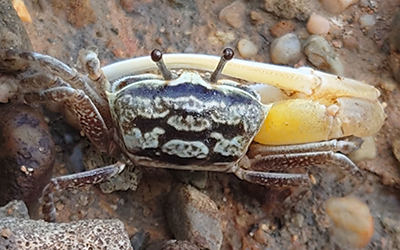
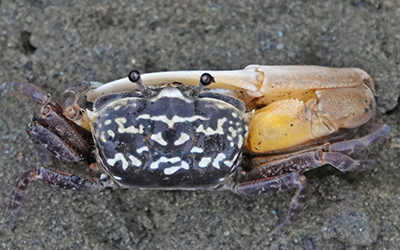
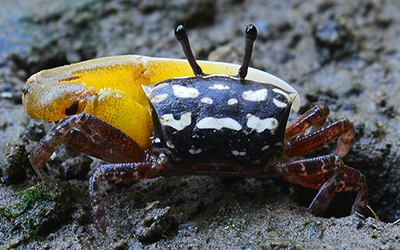
The primary difference between Austruca perplexa and Austruca annulipes is color, with Austruca perplexa leaning more toward yellows and Austruca annulipes leaning more toward reds. Paler forms without color are more difficult to tell apart.
Austruca triangularis is superficially similar in color to both Austruca annulipes and Austruca perplexa, generally having a black/brow and white/cream carapace (occasionally yellow), frequently will broad stripes, and a claw which tends to be off white, but may include yellow. Despite this general similarity, the species should be relatively easy to tell apart.
There are at least three features which can be used to distinguish them. First, the carapace shape is noticably different, with the front corners of the carapace of Austruca triangularis extremely pointy and tending to point more toward the sides than the front, with the sides of the carapace converging much more strongly in Austruca triangularis than in either Austruca lactea or Austruca perplexa. Second, the hand of the large claw in Austruca triangularis is generally covered with brown spots, giving it a polka-dotted appearance (these spots are sometimes foundon the carapace as well). Third, but more subtle, on average Austruca triangularis tends to be smaller than the other two species, although there is overlap in size.
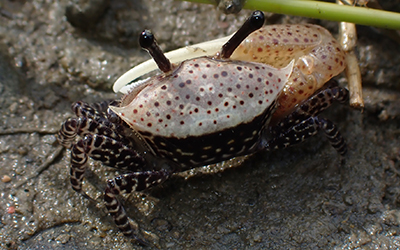
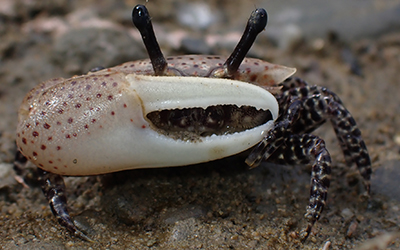
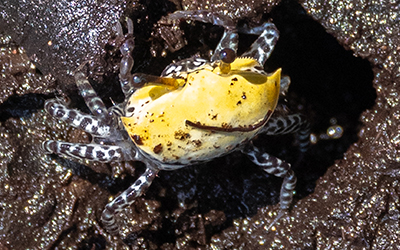
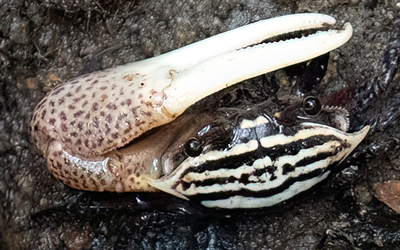
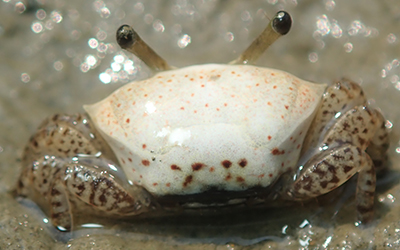
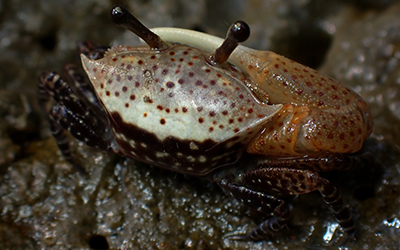

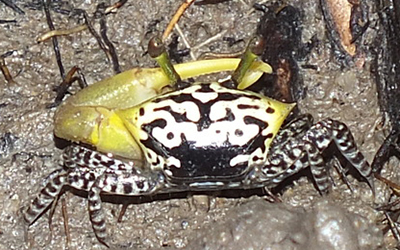
The final broad front species in this region, Paraleptuca crassipes is easily distinguishable from the others by color. The colors of Paraleptuca crassipes do overlap with one of the narrow front species, Tubuca coarctata, described below.
Paraleptuca crassipes is a highly variable species with a carapace that is generally some combiantion of black, pale blue, and bright red—occasionally with a hint of yellow or green—with solid red and all-but-solid black carapaces not uncommon (it seems never to be solid blue). It's eyestalks are usually yellow-green, but sometimes red, particularly in individuals with heavily red carapaces. The large claw is bright red-to-reddish pink, with paler pink or white fingers.
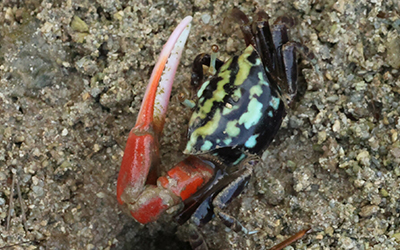
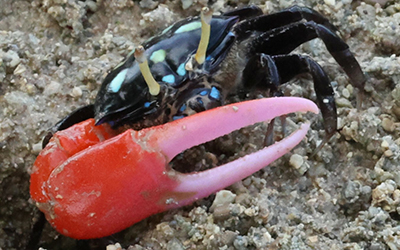
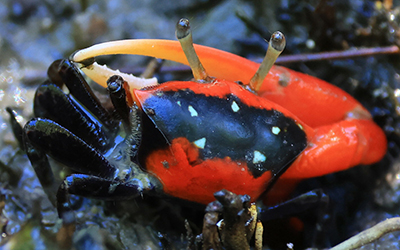
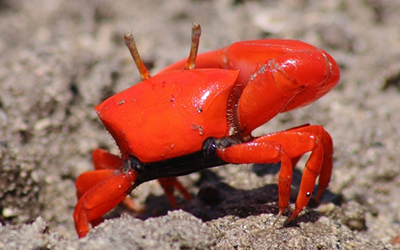
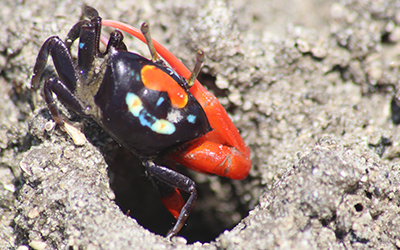
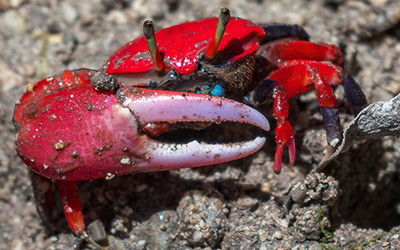
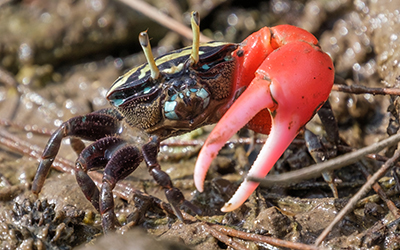

Gelasimus tetragonon is a wide-spread species that is something of an oceanic island specialist, although it is occasionally found on continental shores. It usually has a predominantly blue and black carapace with bright red legs (which occasionally may be darker) and gray eyestalks. The large claw of Gelasimus tetragonon is usually orange, with a noticeably darker red spot near the base of the pollex, and a white dactyl. Gelasimus tetragonon frequently has brown spots on the top part of the hand of the claw.
Gelasimus tetragonon has a lot of additional variability. In some places the carapace can lighten so that there is almost no blue, just a cream or pale orange with black markings. The pattern of the colors on the carapace can vary from stripes or blotches to tiny spots.
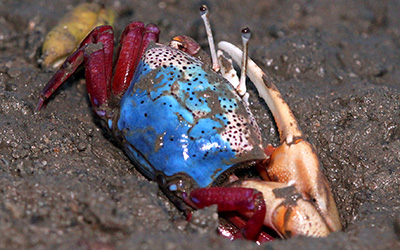
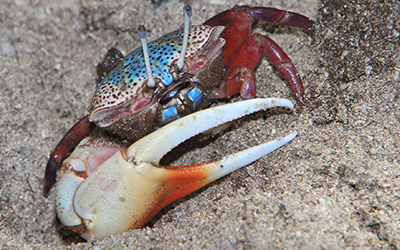
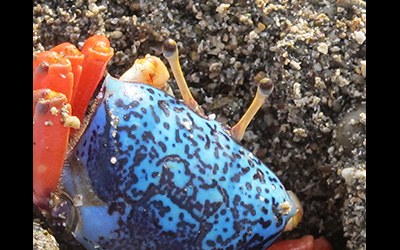
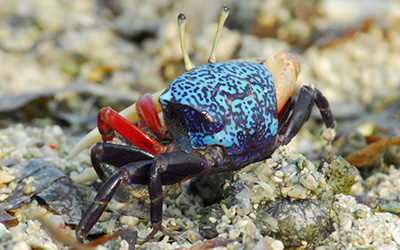
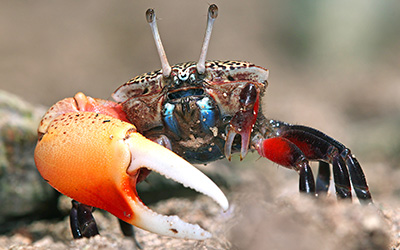
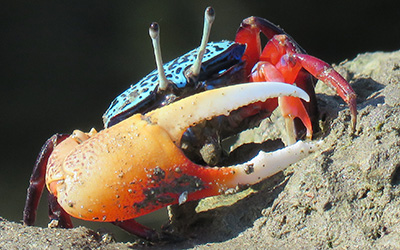
Tubuca rosea tends to be one of the more distinctively colored species. Its carapace is generally semi-translucent, frequently a pale blue or rose red (or both). Its limbs and large claw are generally rose red, with the fingers of the claw a bit paler.
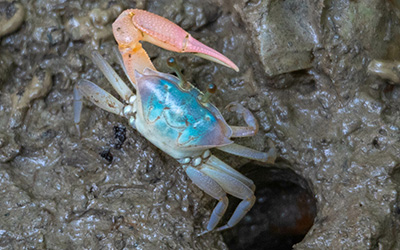
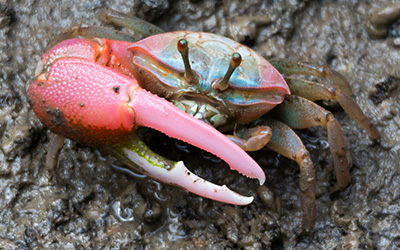

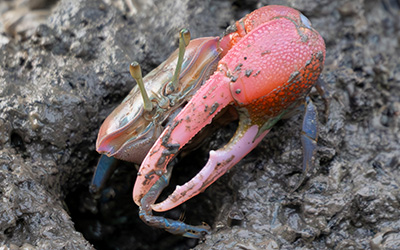
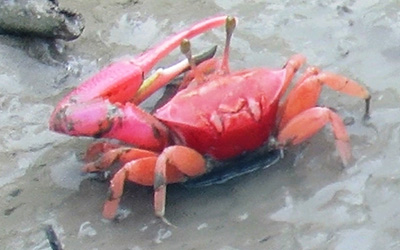
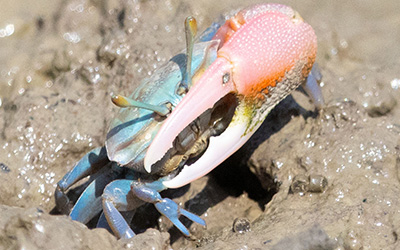
Tubuca forcipata is one of the more variable and confusing species, with multiple color forms that are not particularly similar to each other. One expert on fiddler crabs from the region has suggested that the name currently encompasses multiple, undescribed species being mixed together, but the formal work to determine if this is true and disentangle the various forms has not been completed at this time.
What I would refer to as the canonical form of Tubuca forcipata is a fiddler crab with a dark carapace with pale speckling (either white or pale blue) and a large claw where all or most of the hand is dark purple with the rest of the claw white. The claw is frequently heavily toothed and the tips of the fingers of the large claw often appear to come together as forceps, giving the species its name.
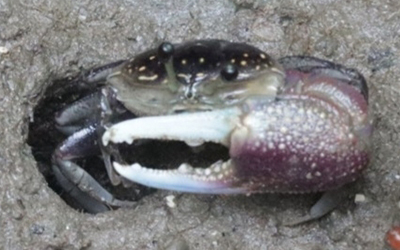
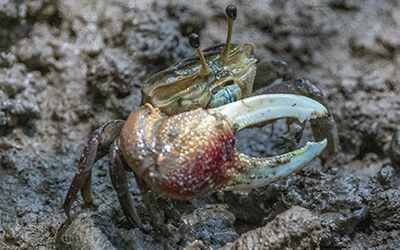
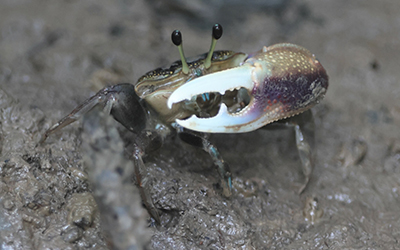
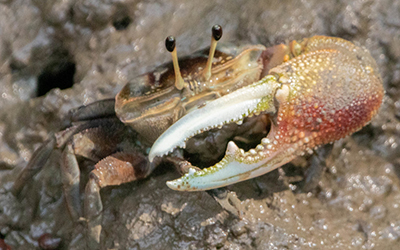
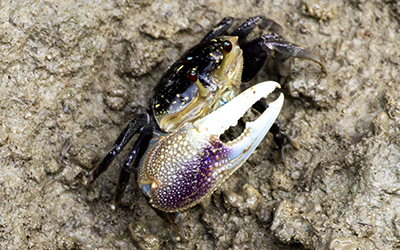
The second color form of Tubuca forcipata is completely different, with the crab a mix of black and bright red, generally with the black on the back half of the body and red on the front half, including the entire claw. The literature suggests that this bright red form is common in juveniles or yournger crabs of this species.
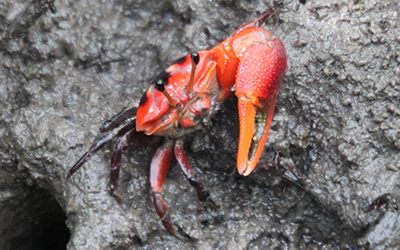
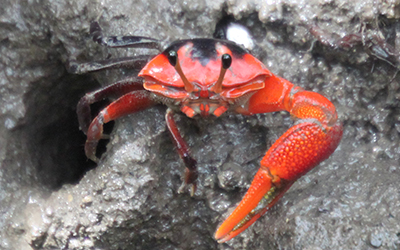
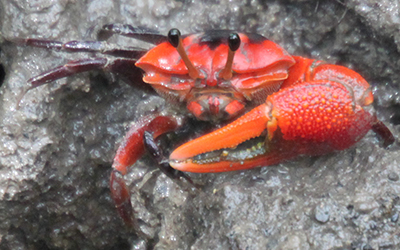
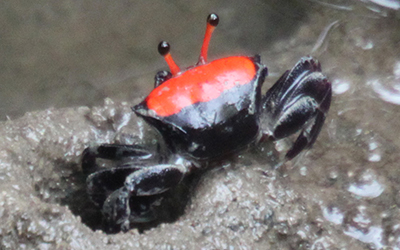
A third color form of Tubuca forcipata is vaguely in between the previous two, although not particularly similar to either of them. In this form, the carapace is generally black with large tan/beige patches toward the front, the legs are frequently pale gray, and the large claw has a dark red hand with orange fingers.
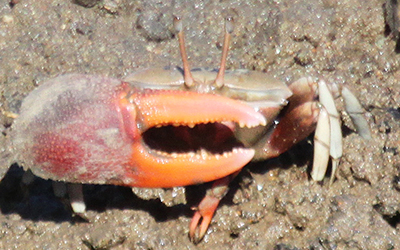

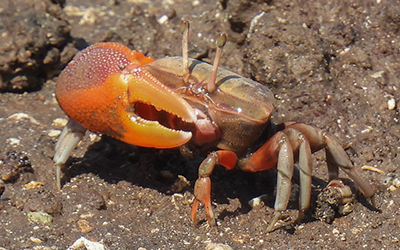
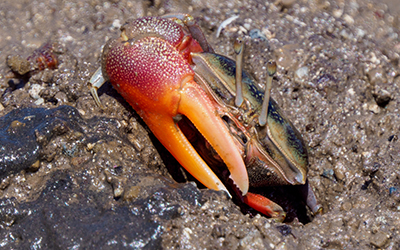
Are these all the same species? Maybe. It could simply be a variable species, the differences might represent age or developmental stage or regional variation. There are some additional patterns beyond color that separate these forms, particularly the first and third. The claw on the first form is notably toothier than the other two. The first and third form appear to have no geographic overlap, with the third form only appearing in the southeastern part of the Malay Archipelago (starting from Bali and including various islands further to the east and south), while the first form is only found further north and west (Borneo, Sumatra, etc.). Conversely, the black and red form (which has been suggested as representing a juvenile stage) overlaps with both of the other two in space, at least in part, as it has been seen from Bali (although not necessarily further south or east) to Singapore and the Malay peninsula.
Tubuca coarctata is a highly variable narrow front species that is most likely to be confused in this region with Tubuca dussumieri or the broad front species Paraleptuca crassipes. Differences between Tubuca coarctata and Tubuca dussumieri will be described below, so this section will focus more on Tubuca coarctata vs Paraleptuca crassipes. On average, front breadth might be the easiest way to distinguish these as the high variaiblity of both species creates a lot of general overlap in color pattern.
The most common carapace pattern in Tubuca coarctata is a mostly black carapace with some spots of pale blue, yellow, red, or white. In many cases, however, individuals may have carapaces that appear nearly solid of any of these colors or consist more of two-toned stripes of two of these colors (the latter pattern might be more common in females than males).
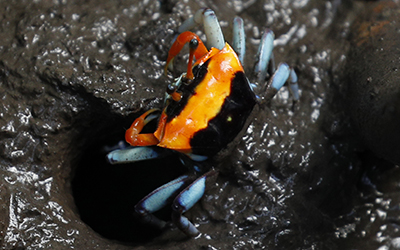

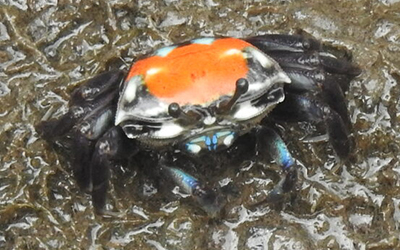
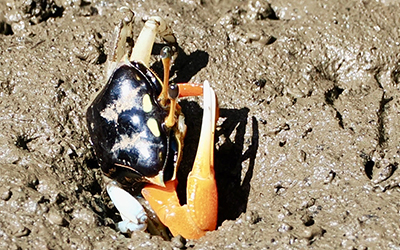
The legs of Tubuca coarctata generally follow this same color variation as the carapace, although the two rear legs generally have a large distinct, pale blue (sometimes almost white) blotch on the rear of the the top segment. This color will sometimes spread beyond this segment.
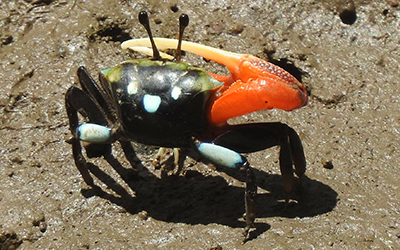
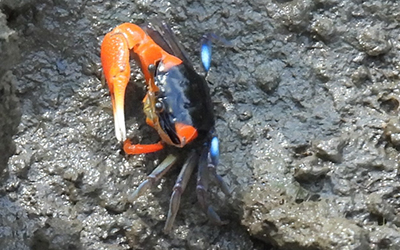

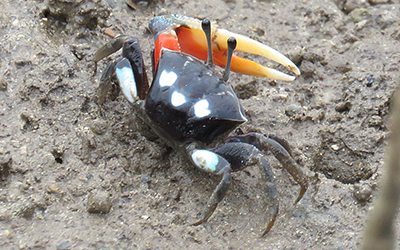
The large claw usually has a red or orange hand, with most of the upper finger and the outer half of the lower finger white. Sometimes the white will bleed further onto the upper part of the hand. There is also usually a darker red patch at the base of the lower finger (as is common in many other species). The prototypical male Tubuca coarctata has a distinct an obvious flat edged projection along the lower portion of the tip of the upper finger of the large claw. In some individuals this feature is more subtle, while other species may have a claw shape that is at least somewhat similar, although within this region this shape is more-or-less unique to this species.
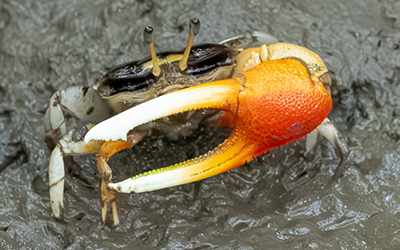

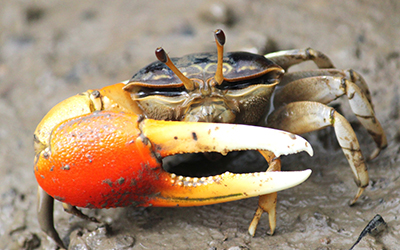

Other than front breadth, the most likely methods of distinguishing Tubuca coarctata from Paraleptuca crassipes are the shape of the tip of the large claw and the presence of the blue spots on the backs of the rear legs. Paraleptuca crassipes also leans much more heavily toward bright reds than Tubuca coarctata, whose redder forms are more orange.
Tubuca dussumieri lacks the extreme variability of Tubuca coarctata but overlaps in color. Tubuca dussumieri generally has a dark blue or black carapace, frequently solid colored although some spotting is possible, which can be similar to that found in Tubuca coarctata, including occasional pale spots on the rear legs.
The large claw of male Tubuca dussumieri is generally two-toned, orange on the bottom and white on the top, with a darker orange/red patch at the base of the bottom finger. The fingers of the large claw tend to be fairly straight, and the upper finger lacks the distinct flattened edge that tends to be found in Tubuca coarctata. There may be some flattening of that finger tip in Tubuca dussumieri, but it is more subtle than that of Tubuca coarctata.
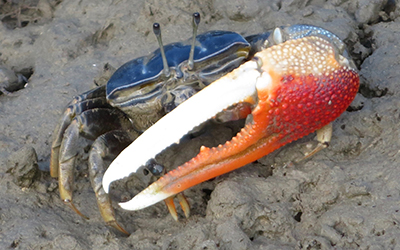
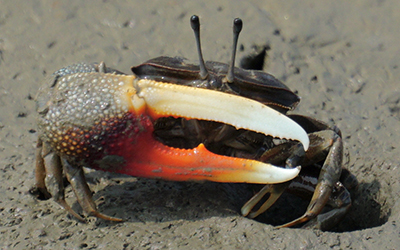
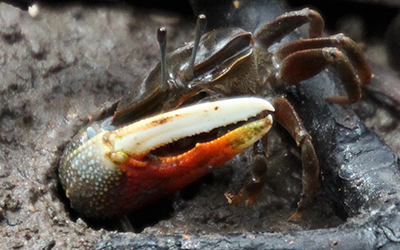
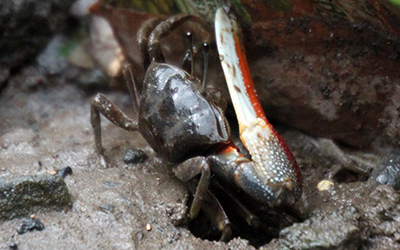
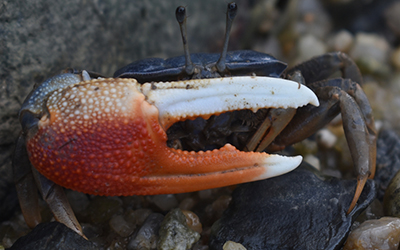
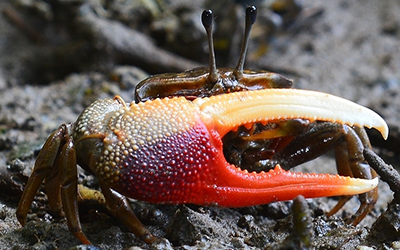
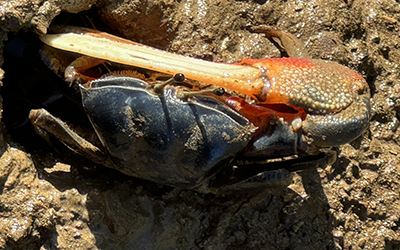
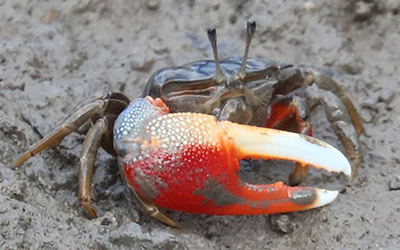
A final feature that distinguishes the two species may be too subtle to see in most cases, but is worth mentioning. Tubuca dussumieri has two long grooves running across most of the length of the upper finger of the large claw; Tubuca coarctata only has one. Unfortunately, these grooves are not always readily visible, particularly as the pale upper fingers of the claw frequently appear slightly overexposed in photographs.

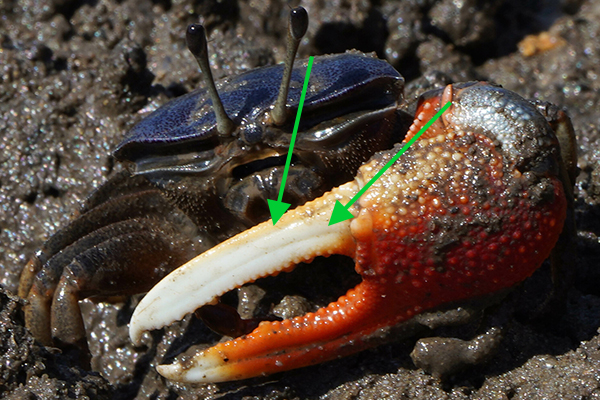
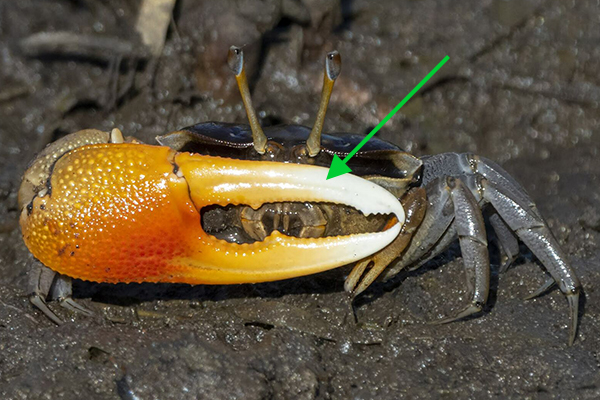
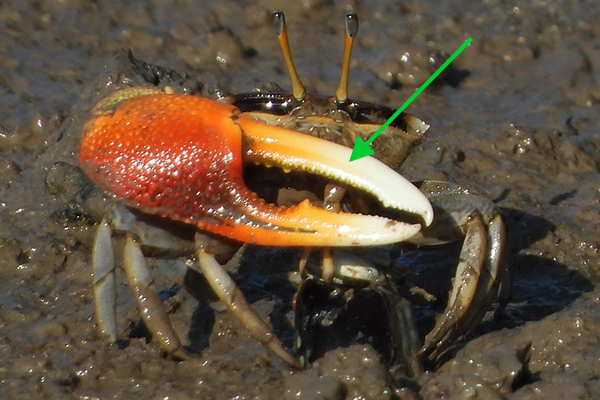
Two species from the subgenus Gelasimus (Gelasimus) are likely present in this region, but they are all but indistinguishable in the field. Gelasimus hesperiae is likely found on the western part of the island, while Gelasimus vocans is likely found on the eastern part, but to what degree they overlap is unclear. There are a few subtle characters that might possibly help to distinguish them, but not only are they frequently difficult to see, none may be universal or entirely reliable.
Gelasimus hesperiae has a white or pale greenish-brown carapace and a distinctively shaped large claw. The dactyl (upper finger) on the large claw is usually white or pink, while the rest of the claw usually ranges from orange to pale yellow. The dactyl is relatively thick and straight for about half its length before clearly curving to a thick point. The pollex (lower finger) will frequently have two very clear large teeth, one about midway along the length and one near the tip, although one or both can be absent. Like Tubuca alcocki, it has large bumps (tubercles) on the hand of the claw and will often have a noticeable groove along the base of the pollex.
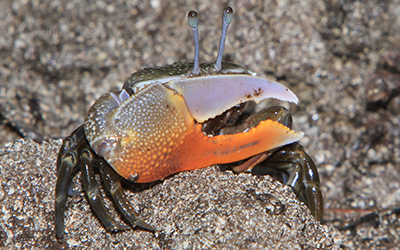
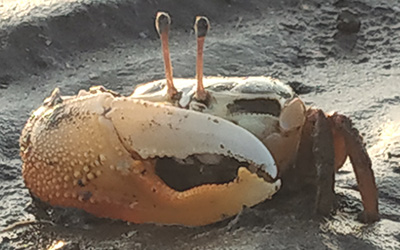
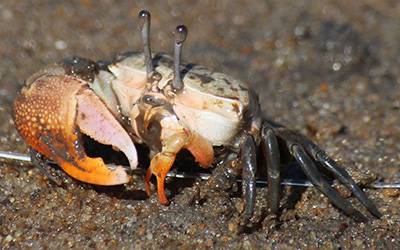
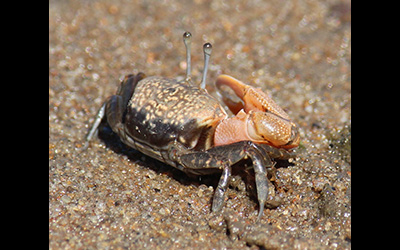
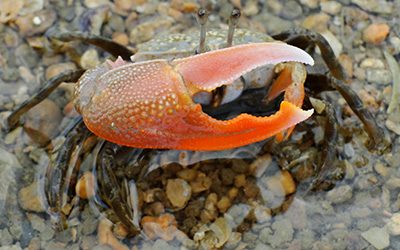
Gelasimus vocans is extremely similar to Gelasimus hesperiae and all but indistinguish in the field. The colors and claw shape are more or less identical.

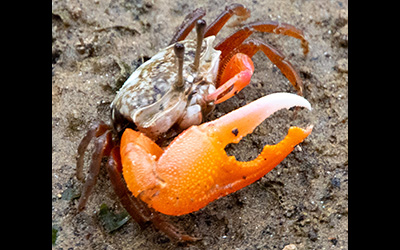

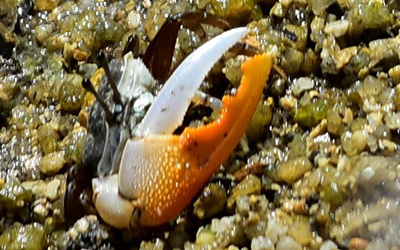
Having stared at lots of photos of both species (taken from areas where they do not overlap), it seems that in Gelasimus hesperiae the dactyl (the upper finger) of the large claw tends to be a bit thicker, particularly where it attaches to the hand, than that of Gelasimus vocans where the dactyl is frequently slimmer. This different is subtle and while there are very few, if any, photos of Gelasimus hesperiae with a particularly thin dactyl, some Gelasimus vocans appear to have a slightly thicker one.
According to the litrature, one very subtle difference which is difficult to see in the field and most photos is in the shape of the small claw on males (and both claws of females). In Gelasimus vocans the gap between the fingers of the small claw tends to be as wide, while on Gelasimus hesperiae this gap is supposedly narrow. I am not entirely convinced that Gelasimus hesperiae consistently has a narrow gap, but it could also be that it is all but impossible to estimate unless the small claw is completely closed, which is rather rare in photographs where you can even see the small claw. Compare the gap in the small claws between these two sets of photos.
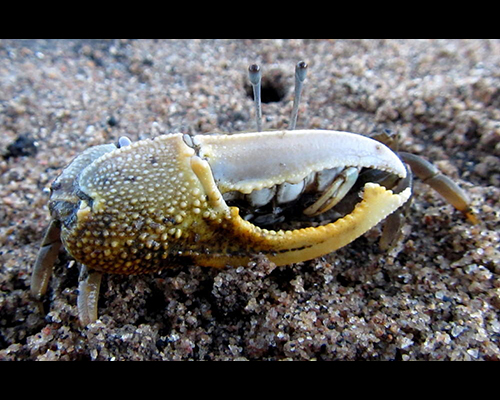
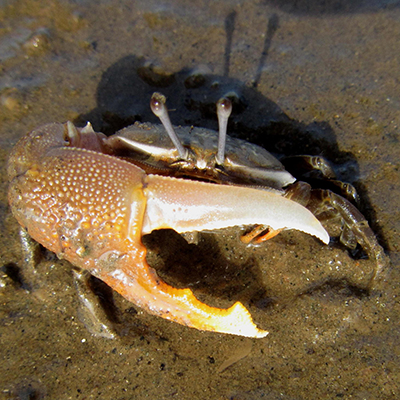
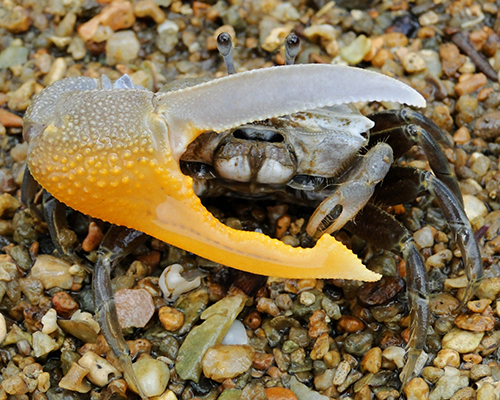
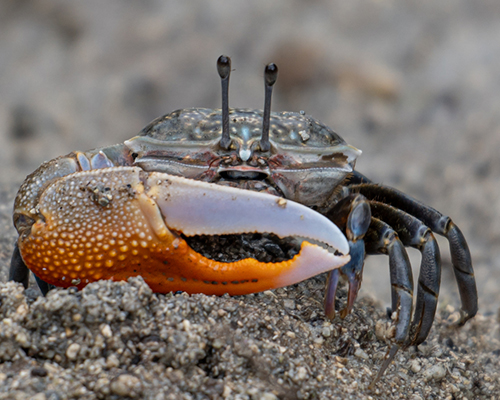
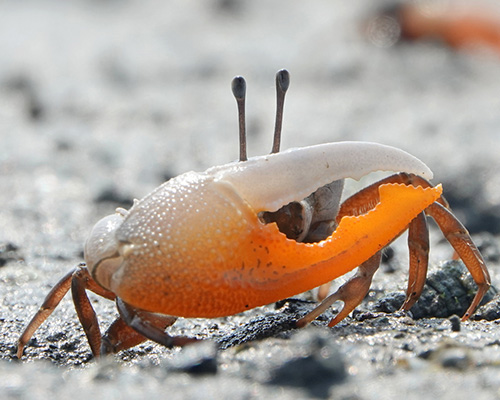
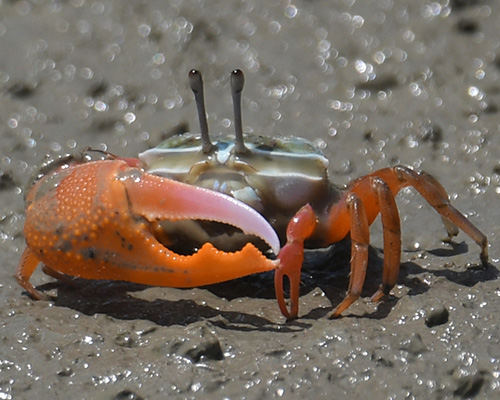
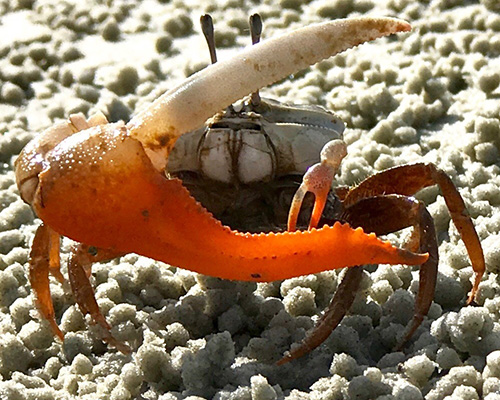
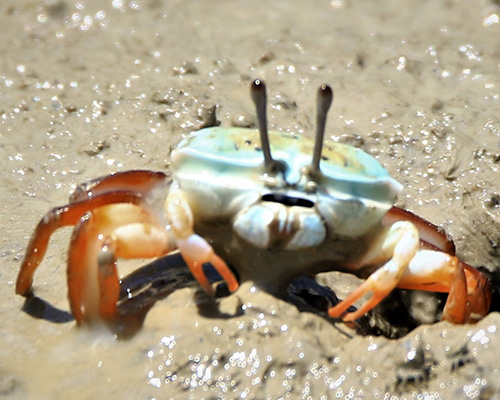
The only other difference I could identify that might distinguish the species without aid of a microscope is a very subtle difference in the shape of the carapace where it extrudes between the eyes. This part of the carapace is known as the front, and the center part of it includes an indented section that sits between the thicker lip that makes up the edges of the front.
In the rare cases where you can see this part of the carapace clearly in a photograph, the shape of the groove in Gelasimus hesperiae has a tendency to be strongly v-shaped, coming to a point between the eyes; in Gelasimus vocans this same groove is a bit wider and shallower and more rounded at the bottom without the sharper point. Unfortunately, this can be extremely difficult to observe and again, I am not convinced it is entirely reliable.
